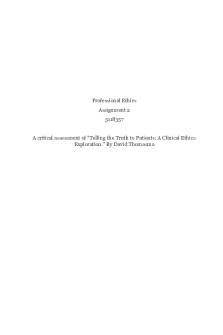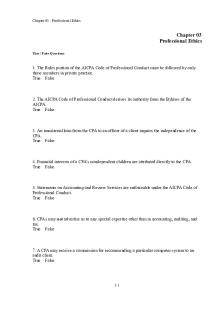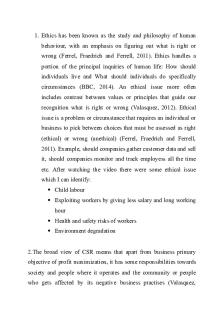Professional Ethics Assignment 2 PDF

| Title | Professional Ethics Assignment 2 |
|---|---|
| Author | Ahmed Hassan A |
| Course | Biomedical Ethics |
| Institution | Athabasca University |
| Pages | 8 |
| File Size | 108.6 KB |
| File Type | |
| Total Downloads | 33 |
| Total Views | 172 |
Summary
Download Professional Ethics Assignment 2 PDF
Description
Professional Ethics Assignment 2 3118357
A critical assessment of “Telling the Truth to Patients: A Clinical Ethics Exploration.” By David Thomasma
Introduction In David Thomasma essay on “Telling the truth to patients: A clinical ethics exploration” he categorizes four types of truth and what concepts those truths revolve around. This research article will delicately assess his reasoning behind the relevance of those concepts to truth in a clinical setting and if his conclusion on always telling the truth is imperative in all cases.
Truth As A Right David lays out three reasons why truth must be told, amongst the first reason is truth is a right. Autonomy is firmly entrenched and irreversibly attached to the dignity of human existence. Principle of autonomy dates back to as many ethicists claim to the philosophical treatises of the French and English Enlightenment. This moment of history illuminated the first light of freedom and liberation. Yet surprisingly, a progress of this significant moment in time fell short in lagged in broadening the concept of Autonomy in physician-patient relationship except for the twenty decades ago.[ CITATION Edm87 \l 4105 ] As Kanatism theory philosophical standing dictates, an exclusive volume of autonomy is prescribed to every human living soul. Ensuing, that human beings are qualified to design laws or rules to be administered. In contrast, this right could be infringed upon, by making decisions for others, because this implies a disregard of this autonomy. The initial model based for the physician to treat any patient was called the paternalistic model. The interplay of truth between the doctor and patient is noteworthy to mention was central to physician-patient relationship but lacked autonomy. The paternalistic model had a very high deficiency in patient autonomy than the later evolved model, where by paternalistic model empowered doctors to act in the best interest of their patients.[ CITATION Mor12 \l 4105 ] On the other hand, the succeeding model also known as the informative model empowered patients with a higher autonomy, thus nullifying any decision-making process to be carried out by the solely by the physician and restricting it to the patient. In terms of withholding information of any prognosis, paternalistic model commonly ensured dissemination of information. So too did the informative
model, which ensured not only the dissemination of information but a more inclusion of patient’s decision in executing a prognosis. Although the appropriate amount of information disclosed to the patient has been disputed, there should be enough amount of information available to the patient in order to successfully acquire an informed consent is warranted. For instance, it is inconceivable by any medical practitioner to conceal a dire illness such as AIDs from a patient. This would not only warrant as a major breach to the patient-physician relationship but also a far infringement to the standard of informed consent any patient is entitled to. Therefore, the basis of truth is the fundamental principle which patients rely on for informed consent. A necessary process which pursues benevolence of a patient thus requiring a full disclosure of any information pertaining to his/her diagnosis to reach a potentially qualified informed consent.
Healthcare gradually veered away from a paternalistic model to a more informative model spanning through the past three decades. A central point to that movement in essence was the principle of patient autonomy. An informative model endows patients with inalienable rights to be involved in decisions about their health care and indeed finally to provide informed consent for any viable treatment option. Later, if physicians accept that any terminal illness needs to be treated (even if this treatment is limited to palliative care) then morally and legally, informed consent must be given, and it is difficult to accomplish this when the patient's essential diagnosis and prognosis are withheld from him or her.
Utility as a right According to the paternalistic model and coinciding with the value or principle of utility, doctors or physicians should conceal bad diagnosis from patients or patients’ families. This approach reverts back to the concept of utility and how it balances benefits and harms. This assertion concurs with Kant’s moral philosophies and principles such as utilitarianism which states that moral or good
acts are classified depending on the amount of happiness they render to the greater majority versus the amount of sufferings.[ CITATION Row03 \l 4105 ] Working with this type of approach of concealing is within the posture of the paternalistic model. Conveyance of the truth about a disease or terminal illness is difficult as a majority of physicians presume it is, belittling immorality of concealing the truth to their patients. Physicians usually equate not telling the truth in these particular causes to minimize inflicting harm, or disclosing the truth as long as it didn’t harm them[CITATION Dra \l 4105 ]. Furthermore, the centrality of non maleficence justifies instituting a conduct of avoiding exposing the truth when fatal or serious diagnoses is involved. Another reason for physicians to refrain from laying out an accurate prognosis considering the circumstances we have mentioned is a misinformation occurs from the side of the patient. Amongst the physicians who argue this is Lipkin stating “ [t]he news of serious illness drives some patients to irrational and destructive behavior”.[ CITATION Mare4 \l 4105 ] This argument is refuted by underling what Roger Higgs calls it a “human failing”. Claiming the patients don’t have the technical background is refuted by mismatching difficult with an unimportant. Higgs emphasizes on the methodology and magnitude of information passed to the patient. Likewise, communication as he puts it is an art and with adequate practice a physician would be able to convey the right amount of information in a comprehendible language away from sophisticated terminologies. Purposefully, informed consent is established only when the patient is given the information, he/she needs as a reasonable person to make a reasonable choice. [ CITATION Hig15 \l 4105 ] Moreover, cases where no cure is probable or possible, a consideration of preserving patient’s happiness will eliminate any opportunity for planning of an unfortunate death. This ensues depriving dying parents from securing a decent care for their children or settling unresolved issues which could be only resolved with sustaining livelihood of those individuals. Therefore, Higgs argue that disclosing the truth, must be a standard position. Consequences and results of hindering a patient’s knowledge of their current circumstance pertaining to one’s health is easily interpreted as disrespectful in its utmost meaning. Central to one self welfare is only perceptional to their beliefs and opinions, since these opinions
are not reflected in the decision made on factual basis (as opposed to being lied too) , the patient’s autonomy is disparaged. If the consequence of telling the whole truth would be of harm to the next of kin, the carers could consider hiding parts of it to protect next of kin. The same stance was also described for communication after the death of a patient. Just how distressing and arduous the last period of life had been for a patient who had had a difficult death was information suggested to be withheld from the next of kin. If next of kin had not been present when death occurred, details could be omitted, and more general descriptions provided. Reasons for this were among others to save the next of kin from unnecessary emotional outburst. Meanwhile, in a circumstance were lying to a patient for a short period of time is a justifiable act. An understanding of the pace of patient’s recovery, their personality and how prone they are to fortunate and unfortunate news, is essential. But this trajectory, must in all cases be dealt with caution and high sensitivity. Usually, medical practitioners misjudge patients’ expectations & convictions. Let alone the slippery slope this practice might lead to which would be a continuation of lies. Best case scenario, this argument is a guard of telling the truth within a period of time. In contrast, more traditional physicians tend to warrant a mediocre level of competency beholden by their patients, where a full medical disclosure of their diagnosis sparing no detail occurs. Patient’s knowledge shouldn’t be limited to either everything or an absolute nothing in relation to their diagnosis. A sticking balance should mediate between these two extremes. A natural presumption of this patient would be in fair amount of knowledge to execute a sound judgment. While a patient being ignorant of minor details anticipated only by doctors is inherent. Thus, leaving a middle ground enabling patients to be more self aware and open more room if patients are willing to quench their thirst of knowledge.
Kindness A Virtue Virtue ethics focuses on the traits of the individual rather than consequentialism or the means to achieve specific goals. Deliberating virtue ethics demonstrates a physician’s responsibility of upholding the patient and the public health embodied by the collective safety of everyone with utmost importance. Thomasma explores kindness in the realm of virtues which as a theory builds upon a person’s behaviour in general and in a physician’s in particular. On the contrary, deontology and utilitarianism involves an action which has the most utility in its outcome or uphold dutiful respect for individuals. Evidently, developing an authentic companionship including a person occasionally misleading another person is the least to say difficult. Likewise, building a trustful physician-patient relationship is seemingly inexistent if it lacked trust. In clear terms, a continuum should be maintained midst either extremes of full knowledge or absolute ignorance a possibility in continuum that the relationship In his essay, David Thomasma lays a case where a dying victim in a vehicular collision is told in his final minutes of life that his family who happened to be with him are going to be taken care of financially ,even though his family members are actually dead. There are distinctive characteristics of this case which are incompatible with any other case. First of all, Thomasma state that this case has particular circumstantial factor associated with the patient. Emergency cases inherently calls upon a different requirement such as no informed consent. Patients in fatal accidents suffer immeasurable pain leaving them a small window of time for any consent to be considered. However, it is completely different situation for a thyroid inflammation patient. In general, majority of cases such as these have a wider window of time between diagnosis & fatality. Regardless of the amount of time quantified whether it is couple of days or multiple weeks, a decision should be deliberated to transfer the patient to an intensive care unit or not. Naturally, instances such as these are far fetched in all respects that patients acknowledge their diagnosis along with their prognosis. Whatever benefit would result out of not revealing the truth, health professionals should consider the worst-case scenario. Consequently disrespecting the patient for no compensating benefit. Neeedlesstosay, the physicians, would have ruined any prospects to create a fruitful physician-patient relationship.
Kindness must be measured in the context of rights & obligations as Thomasma indicates, where goals must be weighed against actions. As he says “If nothing toward the goal can be gained by telling the truth at a particular time, still it must be told for other reasons.”[ CITATION Dav08 \l 4105 ]
This article has contended that the default position for doctors and other medicinal services specialists is to tell their patients the truth. The reason for this are: regard for people, utility, and consideration. Telling patients the truth need not be done, in any case, 'all at once'. To be sure, as a rule, it is smarter to consider being transparent to patients as a procedure, which regularly starts by getting the able patient to tell his/her own record of what he/she comprehend about his/her condition and the amount he/she needs to be told. Given that patients have a right as opposed to an obligation to be told the truth, patients can choose for themselves that they would prefer not to be up to date with their medical circumstance and that their intermediaries should settle on choices for them. This might be particularly valid for those societies that don't hold dear truth telling and independence as much as is as of now the case for the dominant part in North America and the rest of the developed world. Situations where truth will be retained for significant stages of time will be exceptionally uncommon and the weight of concealment will descend unequivocally on those who choose to.
References Drane, Dr. James F. n.d. "Honesty in Medicine: should doctors tell the truth?" Interdisciplinary center for studies in bioethics http://www.uchile.cl/portal/investigacion/centro-interdisciplinario-deestudios-en-bioetica/publicaciones/76983/honesty-in-medicine-should-doctors-tell-thetruth#top8. Higgs, Roger. 2015. "On telling patients the truth" Bioethics an Anthology. John Wiley & Sons . Lipkin, Mark. 1979, June 4 . "On telling patients the truth." Newsweek 13. Moreau, Alain,Carol, Laurent,Dedianne, Marie Cécile,Dupraz, Christian,Perdrix, Corinne,Lainé, Xavier,Souweine, Gilbert. 2012. "Medical Decision Making: What perceptions do patients have of decision making (DM)? Toward an integrative patient-centered care model. A qualitative study using focus-group interviews." Moreau, Alain⁎ 6. Pellegrino, Edmund D. 1987. The Conflict between Autonomy and Beneficence in Medical Ethics: Proposal for a Resolution. Journal Of Contemperary Health Law & Policy https://scholarship.law.edu/jchlp/vol3/iss1/7/?utm_source=scholarship.law.edu%2Fjchlp %2Fvol3%2Fiss1%2F7&utm_medium=PDF&utm_campaign=PDFCoverPages. Rejnö, Åsa, Gunilla Silfverberg, and Britt-Marie Ternestedt. 2017. Reasoning about truth-telling in end-oflife care of patients with acute stroke. Stockholm: SAGE. Rowan, John, and Samuel Zinaich. 2003. In ethics for the profession. Toronto, ON:: Wadsworth/Thomson Learning....
Similar Free PDFs

Professional Ethics Assignment 2
- 8 Pages

Professional Ethics for Lawyers
- 68 Pages

Professional responsibility and Ethics
- 165 Pages

Professional Ethics Complete notes
- 41 Pages

Professional Ethics for Lawyers
- 68 Pages

GE6075 professional ethics
- 89 Pages

Seminar 6 Professional Ethics
- 2 Pages

Chapter 3 professional ethics
- 34 Pages

340909679 Professional Ethics Notes
- 102 Pages

Seminar 6 Professional Ethics
- 2 Pages

Ethics Assignment 2
- 6 Pages

Ethics assignment 2
- 5 Pages

Business ethics. Assignment 2
- 11 Pages

Professional Ethics for Lawyers-1
- 68 Pages

Core duties in Professional Ethics
- 16 Pages
Popular Institutions
- Tinajero National High School - Annex
- Politeknik Caltex Riau
- Yokohama City University
- SGT University
- University of Al-Qadisiyah
- Divine Word College of Vigan
- Techniek College Rotterdam
- Universidade de Santiago
- Universiti Teknologi MARA Cawangan Johor Kampus Pasir Gudang
- Poltekkes Kemenkes Yogyakarta
- Baguio City National High School
- Colegio san marcos
- preparatoria uno
- Centro de Bachillerato Tecnológico Industrial y de Servicios No. 107
- Dalian Maritime University
- Quang Trung Secondary School
- Colegio Tecnológico en Informática
- Corporación Regional de Educación Superior
- Grupo CEDVA
- Dar Al Uloom University
- Centro de Estudios Preuniversitarios de la Universidad Nacional de Ingeniería
- 上智大学
- Aakash International School, Nuna Majara
- San Felipe Neri Catholic School
- Kang Chiao International School - New Taipei City
- Misamis Occidental National High School
- Institución Educativa Escuela Normal Juan Ladrilleros
- Kolehiyo ng Pantukan
- Batanes State College
- Instituto Continental
- Sekolah Menengah Kejuruan Kesehatan Kaltara (Tarakan)
- Colegio de La Inmaculada Concepcion - Cebu
